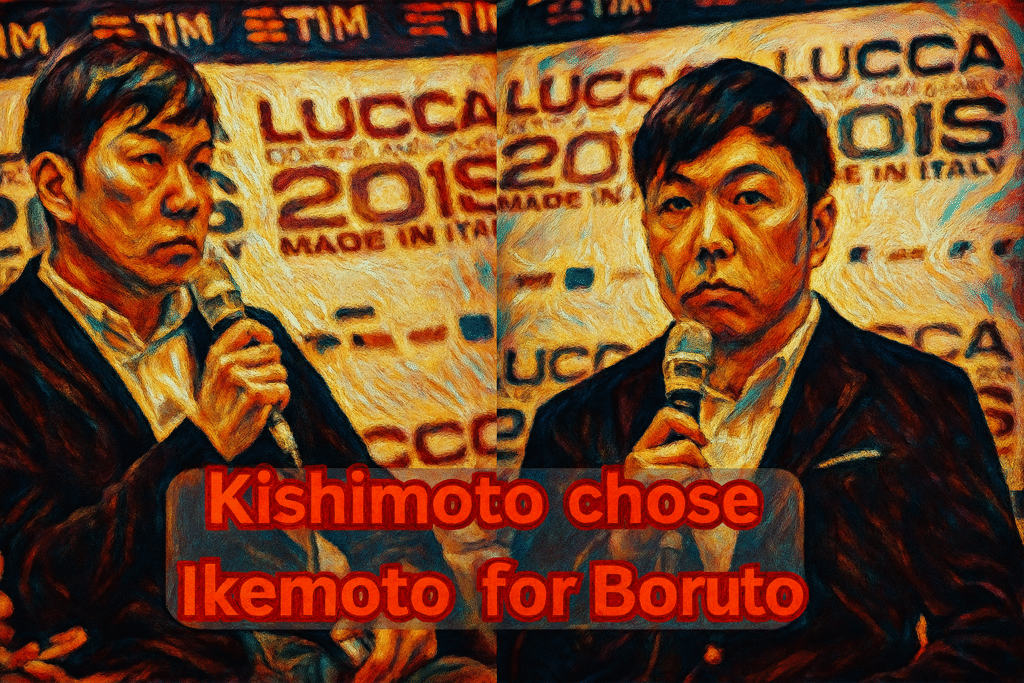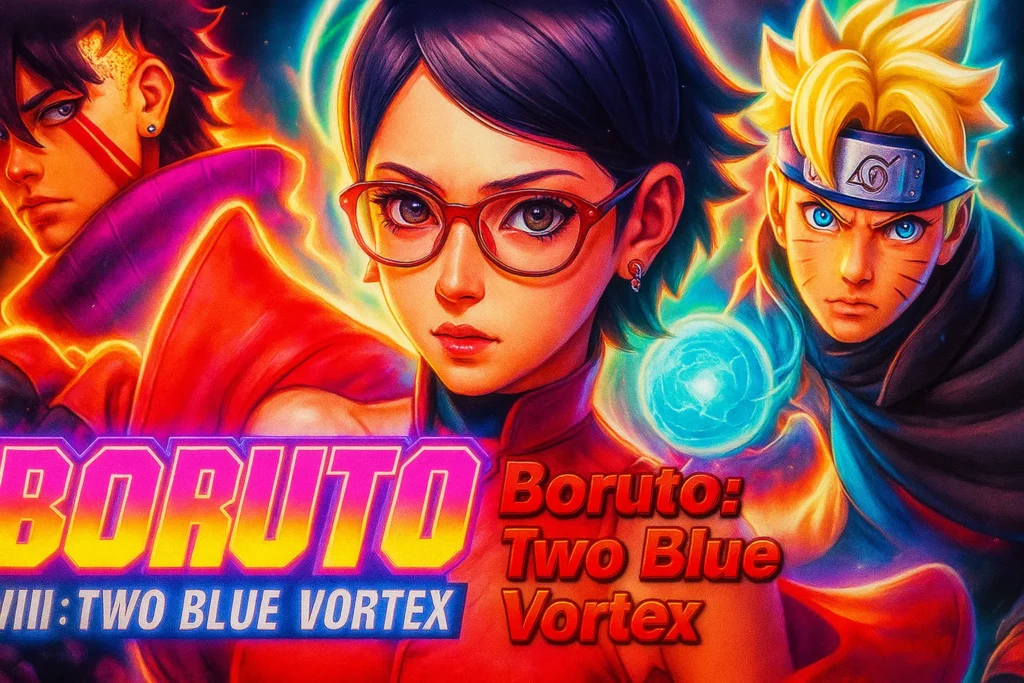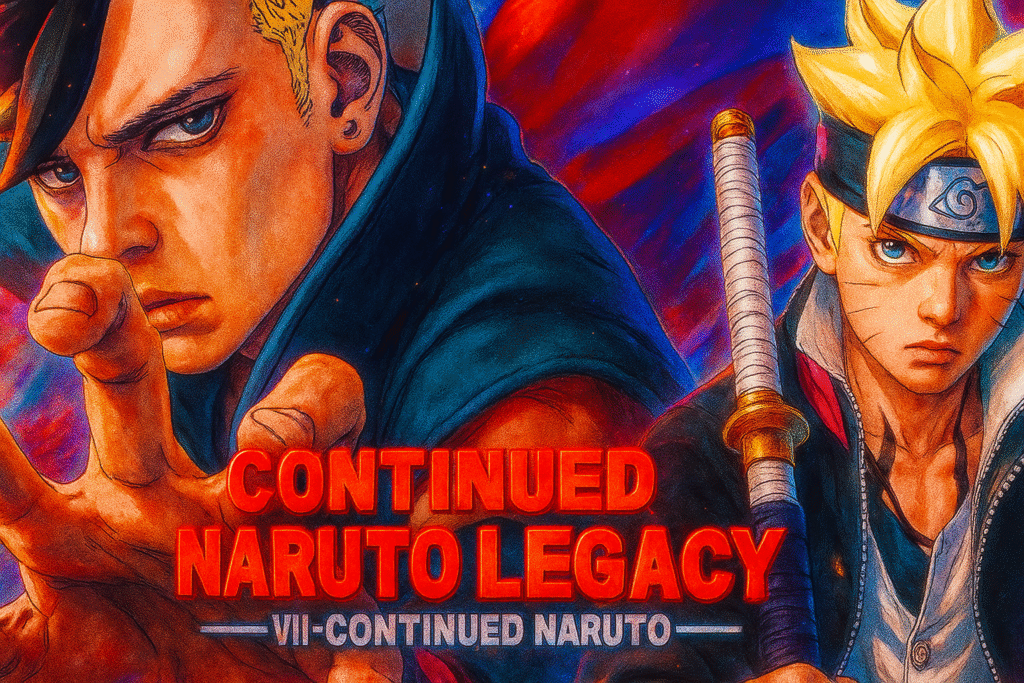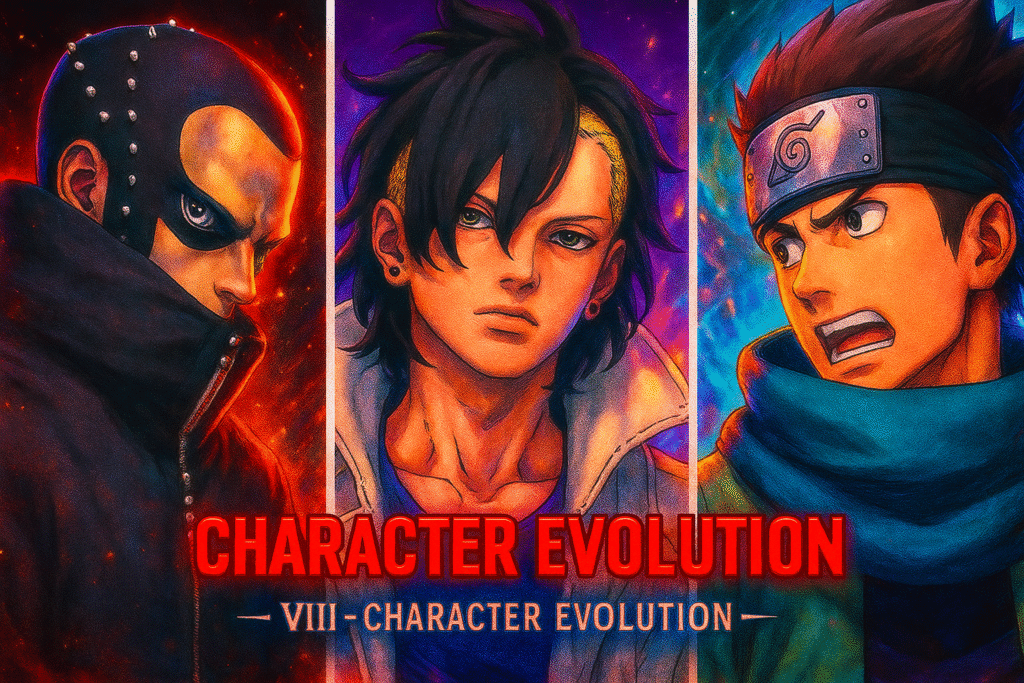When Naruto wrapped up in 2014, fans wondered what was next. Shueisha offered Masashi Kishimoto a chance to continue the saga, but Kishimoto declined to draw Boruto himself. Instead, he recommended his longtime assistant, Mikio Ikemoto, to take the art helmen.wikipedia.orgen.wikipedia.org. In essence, “Kishimoto chose Ikemoto for Boruto” – handing off his legacy. Why did he make that choice? This deep dive looks at Kishimoto’s rationale, Ikemoto’s background, how storytelling and art shifted (especially in Two Blue Vortex), how fans reacted, and what it means for Boruto’s future.
Why Kishimoto chose Ikemoto for Boruto
When the Naruto manga ended, Shueisha asked Kishimoto if he’d draw a sequel. According to Wikipedia, “Kishimoto rejected the idea and proposed artist Mikio Ikemoto, who had been working as an assistant for Kishimoto ever since Naruto’s early chapters”en.wikipedia.org. In other words, Kishimoto told them: “I’m not drawing it, my assistant is.” Why? Several reasons are cited by Kishimoto himself and close observers:

- Trust and Experience:Ikemoto had worked with Kishimoto for years – even from Chapter 7 of Naruto, doing backgrounds, crowds, speed lines and other detailsen.wikipedia.orgnaruto.fandom.com. Kishimoto believed Ikemoto had the right experience. As Kishimoto later explained in an interview, he initially wrote broad outlines for Boruto and allowed Ikemoto to flesh them outcomicbook.com. This shows he trusted Ikemoto’s creative skill.
- Creative Freedom: Kishimoto did not want Ikemoto to merely imitate him. He explicitly advised Ikemoto to develop his own art style, not to copy Kishimoto’sen.wikipedia.orgen.wikipedia.org. In interviews, Kishimoto emphasized that Ikemoto was “fully in charge” of Boruto and he (Kishimoto) “just enjoy[s] reading it”comicbook.com. This indicates Kishimoto was more comfortable guiding than drawing. By stepping back, Kishimoto let the new series grow on its own terms.
- Ambitious Goals: Even so, Kishimoto had high hopes for Boruto’s story. He said he wanted Boruto to “surpass his own work”en.wikipedia.org, meaning he hoped the sequel would exceed Naruto. Handing the art to Ikemoto allowed Kishimoto to focus on plotting and overall vision. He could ensure Boruto had the right direction (for example, adding hints of a darker future early on)en.wikipedia.org without doing the heavy drawing.
- Workload and Legacy: After a grueling decade on weekly Naruto, Kishimoto may have welcomed a reduced workload. ComicBook.com’s interview summary reveals Kishimoto calling Boruto “the truest collaboration” with Ikemoto. He wrote succinct story drafts and let Ikemoto suggest changes before drawing chapterscomicbook.com. Kishimoto even admits that Ikemoto is now fully in charge of the seriescomicbook.com. In short, Kishimoto chose Ikemoto to keep Boruto alive under trusted hands, while he oversaw it from behind the scenes.
Mikio Ikemoto: From Assistant to Lead Artist
So who is Mikio Ikemoto, and why was he Kishimoto’s pick? Ikemoto had long been Kishimoto’s assistant – in fact Narutopedia notes he was Kishimoto’s third assistant over Naruto’s 15-year runnaruto.fandom.com. Kishimoto personally recruited the young artist early on, asking his editor to scout Ikemoto when Naruto beganen.wikipedia.org. Ikemoto started on Naruto Chapter 7 and spent years drawing crowds, background figures, speed-line highlights and more for Kishimotoen.wikipedia.orgnaruto.fandom.com. Kishimoto even gave Ikemoto some original character design tasks (like designing Haku and Zabuza’s attire)naruto.fandom.com. This apprenticeship meant Ikemoto knew Naruto’s world inside out.
By the time Boruto was being planned, Ikemoto had the resume. In fact, Wikipedia confirms that “Ikemoto was chosen to illustrate the 2016 sequel [Boruto: Naruto Next Generations], working alongside writer Ukyo Kodachi”en.wikipedia.org. Kishimoto himself acknowledged Ikemoto’s years of experience in this choice. Importantly, while Ikemoto’s art style resembles Kishimoto’s in line quality, Kishimoto urged him to be originalen.wikipedia.org. Ikemoto agreed and was “optimistic about his art style” for Borutoen.wikipedia.org.
In short, Ikemoto had proven skill and was Kishimoto’s protégé. When Kishimoto said Ikemoto was ready, fans and editors knew he could handle the art duties. This led to Boruto debuting with Ikemoto on art from Day One, under Kodachi’s story supervision.
Collaboration and Story Shifts in Boruto
Boruto’s creation was a team effort. Boruto: Naruto Next Generations launched in 2016 with Ukyo Kodachi as writer and Mikio Ikemoto as illustrator, with Kishimoto as editorial supervisoren.wikipedia.orgen.wikipedia.org. In that setup, Kishimoto set broad plot points, Kodachi fleshed out scripts, and Ikemoto drew the pages. Over time, that collaboration evolved:
- Story Outlines by Kishimoto: ComicBook.com reports that Kishimoto would draft a rough story outline for each arc, then meet with Ikemoto to discuss it. Ikemoto could propose changes, and once they agreed, Ikemoto would draw the detailed storyboards and dialoguecomicbook.com. This back-and-forth process ensured Kishimoto’s vision guided the series while leveraging Ikemoto’s creativity.
- Dynamic Creative Roles: As Kishimoto later noted, in practice “Ikemoto-sensei is really the one who is fully in charge of Boruto… I just enjoy reading it!”comicbook.com. This frank admission shows Kishimoto viewed Boruto as largely Ikemoto’s domain. Ikemoto himself confirmed that after the series began, the plot started to diverge from Kishimoto’s outlines. Today Ikemoto and his editor plan chapters monthly, and Kishimoto sometimes “doesn’t yet know what’s going to happen next in Boruto”comicbook.com. In effect, the original creator entrusted his assistant completely, intervening mainly to advise and approve key elements.
- Kishimoto’s Creative Inputs: Despite handing over control, Kishimoto did seed some of Boruto’s initial ideas. For example, early in the manga Kishimoto suggested starting with a glimpse of a bleak future for Boruto – showing an older Boruto and Kawaki in battle – to give the series dramatic stakesen.wikipedia.org. This idea from Kishimoto set the tone and was different from the lighter Boruto movie. It illustrates how Kishimoto’s influence shaped the story setup, even if he wasn’t drawing the art himself.
- Leadership Change: In November 2020, writer Ukyo Kodachi stepped down and Kishimoto formally took over as Boruto’s official writeren.wikipedia.org. This continued the trend of Kishimoto becoming more directly involved, now writing full chapters. The manga was also moved to V Jump in 2019, and after a short hiatus, relaunched in August 2023 with the new arc
- Boruto: Two Blue Vortexen.wikipedia.org. In this Two Blue Vortex era, credits list “Masashi Kishimoto” as author and “Mikio Ikemoto” as illustratoramazon.com, affirming their roles. Two Blue Vortex takes the story into new territory (with a timeskip and more serious themes), reflecting Kishimoto’s narrative control and Ikemoto’s matured art.

Two Blue Vortex and the New Direction
The Boruto: Two Blue Vortex arc (which began in late 2023) represents a notable shift. Under Kishimoto’s sole writing, the manga jumped four years ahead and turned darker and more mature. Fans and critics have observed that Two Blue Vortex feels more like Kishimoto’s style. One write-up even says this arc has “literally and figuratively moved out of Naruto’s shadow,” establishing Boruto’s own identitycomicbook.com. The focus on deep bonds and high stakes (for example, Boruto’s and Kawaki’s swapped fates) is in line with Kishimoto’s storytelling strengths.
Artistically, Ikemoto’s work also evolved. In Two Blue Vortex, the drawings are more dynamic and detailed, showing how Ikemoto has grown since Boruto’s early chapters. Kishimoto encouraged this: as early as 2016 he told Ikemoto not to imitate Naruto’s arten.wikipedia.org. Ikemoto later refined his figures and action scenes (the monthly schedule, rather than weekly, gave him time to polish pagesen.wikipedia.org). Even Kishimoto himself noted he “improved [his] drawing for Boruto” with new techniques. The result is a fusion of Kishimoto’s narrative and Ikemoto’s steadily improving visuals.
The change is especially clear in Two Blue Vortex. Boruto is older, more conflicted, and the series often shows more dramatic clashes. Kishimoto’s influence – borne from his original vision and new writing credit – ensures the story hits emotional highs (for instance, emphasizing Boruto’s sacrifice and loss). Meanwhile Ikemoto delivers vivid layouts of those scenes. In short, Two Blue Vortex shows the partnership in full force: Kishimoto’s “story and Kimura’s art” (as one commenter noted, though they meant Ikemoto) making Boruto feel epiccomicbook.comfandomwire.com.
Fan Reactions: Praise and Criticism
Kishimoto appointing Ikemoto sparked intense fan debate. When Boruto began, many fans were skeptical or critical:
- Artistic Complaints: In Boruto’s early chapters, some fans felt Ikemoto’s art was inconsistent. Sportskeeda reports that a portion of the fanbase “assumed Mikio Ikemoto isn’t great at drawing,” and they “didn’t hold back criticizing the young illustrator”sportskeeda.comsportskeeda.com. These readers complained that Boruto’s pages sometimes looked messier or less polished than Naruto’s. A FandomWire article even summed up the sentiment: it’s “common for Boruto and Mikio Ikemoto to get hate for ‘failing’ its predecessor,” pointing to an art style “visibly different from Masashi Kishimoto’s” and to story choices that sideline older charactersfandomwire.com. In other words, early fan reaction included frustration that Boruto didn’t immediately feel as crisp or classic as Naruto did.
- Character and Story Concerns: Some fans were uneasy with Boruto’s direction (separate from art). FandomWire highlighted that fans think key side characters were sidelined and questioned the new creative teamfandomwire.com. Indeed, any sequel will get flak from purists when the original creator isn’t drawing. As one article noted, fans “questioned whether it was the right call to put Kishimoto’s chief assistant… at the helm of Boruto”comicbook.com. This was not unique to Boruto; anytime a beloved series changes hands, passionate fans worry.
However, many fans also gave Ikemoto time and credit as he settled into the job:
- Growing Appreciation: Sportskeeda’s analysis argues that a lot of the initial criticism was premature. Ikemoto’s art “quality only got better as time progressed,” and many fans who trusted Kishimoto’s choice waited and saw improvementsportskeeda.com. Indeed, today’s Boruto art is more confident, and longtime readers have noticed this evolution. By now, many have accepted Ikemoto’s version of the world, recognizing his strengths (detailed backgrounds, expressive faces, and fast-paced fight choreography).
- Professional Praise: Importantly, several industry figures have praised Ikemoto’s work. The Boruto anime director Hiroyuki Yamashita said he enjoys Ikemoto’s style, noting it’s even “more realistic” than Kishimoto’s in some waysen.wikipedia.org. ANN reviewer Amy McNulty praised Ikemoto’s fight scenes and how well his art resembles Kishimoto’s in key waysen.wikipedia.org. Even Hunter x Hunter creator Yoshihiro Togashi publicly admired Ikemoto’s artworken.wikipedia.org. These endorsements suggest that while some fans gripe, respected manga creators see value in Ikemoto’s clean, detailed approach.
- Fan Support: Over time, many fans who trusted Kishimoto’s judgment have become supportive. After all, Kishimoto chose Ikemoto. Sportskeeda notes that when fans know Kishimoto picked Ikemoto, “a sizable section of the fanbase was optimistic and patiently waited for the art to improve”sportskeeda.com. In community forums, discussions have softened: readers point out how Ikemoto’s unique style gives Boruto its own flavor, and some now prefer it to a direct imitation of Kishimoto.
In summary, fan reaction has been mixed. There was early skepticism (even backlash) about Ikemoto’s art and the new teamfandomwire.comsportskeeda.com. But as the series progressed, many acknowledged Ikemoto’s growth and recognized that Kishimoto’s oversight ensured quality. The transition may have cost Boruto some initial goodwill among perfectionists, but the series has nevertheless found a stable audience and critical respect, especially as Two Blue Vortex demonstrated its strengthscomicbook.comen.wikipedia.org.
Long-Term Impact on the Boruto Series
What does all this mean for Boruto’s legacy? So far, the franchise is doing well. Boruto manga has sold strongly (over a million copies in print by early 2017en.wikipedia.org), and the story has expanded into anime, novels, and games. The Kishimoto–Ikemoto partnership has defined Boruto’s identity and likely ensures a coherent future trajectory:
- Continued Naruto Legacy: By handing Boruto to Ikemoto, Kishimoto kept the series connected to Naruto while giving it room to grow. As one analysis puts it, Two Blue Vortex “moved out of Naruto’s shadow”comicbook.com. With Kishimoto now writing and Ikemoto illustrating, the sequel draws directly from the original creator’s vision. Naruto veterans can trust the story won’t stray wildly off-course, but new readers get fresh energy from Ikemoto’s art and Kodachi’s former input.

- Planned Ending: Kishimoto has spoken about not dragging Boruto on forever. The manga’s own reporting notes that Ikemoto hopes to wrap up the series in under 30 volumes to keep the entire saga (Naruto plus Boruto) under 100 volumesen.wikipedia.org. This shows they have a finite story in mind. In fact, it’s reported that Kishimoto himself aimed to end Boruto with around 40 volumes of Two Blue Vortex. This plan keeps Boruto tighter and focused, rather than an open-ended cash cow.
- Character Evolution: One lasting effect is how characters have evolved under this new team. For example, Boruto himself has matured – at one point Kishimoto even compared Boruto to Sasuke in that he “starts with everything but will lose everything,” underscoring how the story is more tragic than it first appeared. (Kishimoto made similar comments in interviews, highlighting Boruto’s character growth.) These kinds of narrative turns are possible because Kishimoto had the story reins. As characters like Sarada, Kawaki, and others grow up, we see them in ways Kishimoto shaped, with Ikemoto bringing their emotions to life on the page.

- Fanbase and Series Growth: The creative shift has arguably broadened Boruto’s appeal. Some fans who were wary of the start have stuck with the series and now appreciate where it’s going. The anime and manga continue to introduce new themes (technology vs. tradition, parental legacy, redemption) that Kishimoto himself is overseeing. The internal consistency brought by Kishimoto’s supervision means Boruto’s world feels like a true extension of Naruto’s, just a generation later.
In the bigger picture, Kishimoto’s decision to choose Ikemoto was about stewardship: he passed the baton to someone he trusts. And that trust seems well-founded – Boruto is thriving, and the narrative shows a clear direction. Whether fans prefer the old or new style, the facts are that Ikemoto has held up Boruto’s art duties capably, and Kishimoto’s involvement guarantees the story remains on track.
Conclusion
In the end, the key reason Kishimoto chose Ikemoto for Boruto was trust – trust in skill, experience, and loyalty. Kishimoto did not vanish; he remains deeply involved in Boruto’s story, but he let Ikemoto handle the heavy lifting of artworkcomicbook.comcomicbook.com. Ikemoto, having proven himself as Kishimoto’s right-hand man on Naruto, was well-prepared. He knew the series’ aesthetic, respected its tone, and was eager to contribute. As Kishimoto himself said, Ikemoto eventually took “full charge” of Borutocomicbook.com, and Kishimoto became delighted reader rather than illustrator.
The outcome is a Boruto series that has grown into its own. While the art style changed – and some fans objected at first – Ikemoto’s drawing has improved and his own voice now colors Boruto. Storywise, Kishimoto’s oversight (and later direct authorship) has kept Boruto connected to its roots while exploring new territory. The current Two Blue Vortex saga exemplifies this blend: it’s clearly Kishimoto’s vision, filtered through Ikemoto’s hands and Kodachi’s plotting skills.
For Naruto and Boruto fans, this partnership means continuity. Boruto may not be “just Naruto Part 2,” and Kishimoto made sure it wouldn’t be a mere copyen.wikipedia.org. By choosing Ikemoto, Kishimoto planted a new seed that’s grown in unexpected ways. Ultimately, the decision has kept Boruto moving forward. As the manga approaches its conclusion, readers can see that the series stayed true to the ninja legacy – not because Kishimoto did everything, but because he chose Ikemoto, a collaborator he trusted, to carry the torch.
Further Reading: For more on these topics, see our Naruto series analysis and Boruto timeline pages, and check out our article on ninja character evolution in the Naruto/Boruto saga.
